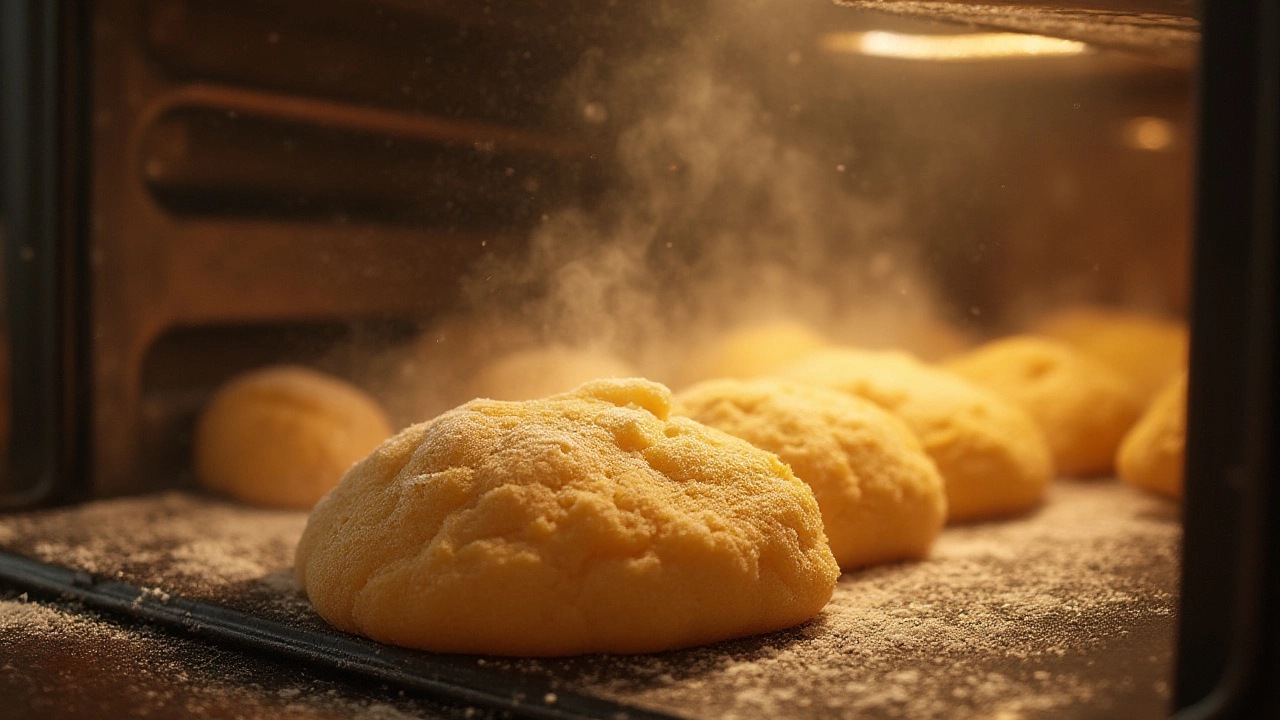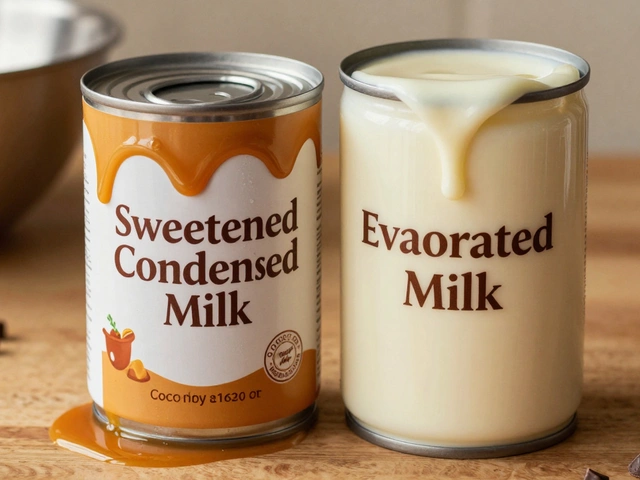
Have you ever peeked into the oven and watched your cookies puff up, transforming from blobs of dough to those golden, crackly domes we all crave? If yours end up flat or hard instead, the real culprit isn’t luck or even your oven—it’s pure kitchen chemistry. The rise of a cookie is a tiny science experiment, right in your own kitchen, and what happens is a lot more wild and fascinating than it seems on the surface. Knowing exactly what makes cookies rise isn’t some trivial secret; frankly, it can be the difference between a tray of mouthwatering masterpieces and a plateful of edible frisbees (my daughter Thalia once called them that, and I’ve never lived it down). Right, let’s get into what actually causes that fluffy magic.
The Chemistry Behind Rising: Air, Gas, and Structure
The moment you cream butter and sugar together, you’re starting the rising process—and you probably didn’t realize it. Creaming isn’t just busywork; it’s beating tiny air bubbles into the butter. Those bubbles create microscopic pockets that, later in the oven, will expand with the help of steam and gases. This isn’t just my theory—food scientists like Shirley Corriher have tracked how proper creaming can literally double the height of a finished cookie.
But air isn’t enough for real lift. Enter the heavy hitters: baking powder and baking soda. Both are leavening agents, but they work in different ways. Baking soda (sodium bicarbonate) reacts with acids in your dough (like brown sugar, yogurt, or even chocolate chips), releasing carbon dioxide bubbles that puff things up. Baking powder, on the other hand, includes both an acid and a base, so it works even in doughs that aren’t very acidic—that’s why it’s common in sugar cookie recipes. There’s a real difference in the cookies too: soda can add a rich, slightly tangy flavor, while powder often gives a bit more loft and a cake-like bite.
The water locked inside your dough joins the party in the hot oven, turning into steam. This steam helps expand the air and gas bubbles, making the whole cookie rise. But too much water, and you’ll get unrealistically puffy, doughy cookies; too little, and they’ll barely move. What’s wild: even your eggs matter here. Yolks add richness, but whites are mostly water and protein—meaning more lift and structure as they coagulate in the oven. More egg whites? Thicker, taller cookies. More yolks? Chewy, richer, but maybe not quite as tall. My son Dariel, who’s all about thick, cake-like snickerdoodles, always reminds me when I forget to add that extra egg white.
Then there’s flour. Using all-purpose, whole wheat, or cake flour actually changes how the proteins (mainly glutenin and gliadin) mesh together. That gluten stretches and traps the gases released by chemical leaveners and steam. If you whip the dough too much, or use high-protein bread flour, you’ll wind up with tough, dry cookies. Not enough mixing, and your cookies won’t hold their shape—sort of like building an inflatable house out of plastic wrap. Striking the balance is key.
Leavening Agents: Choosing and Using Them Right
Choosing between baking soda and baking powder can feel random, especially when recipes mix both or call for one over the other. Here’s the scoop: Baking soda needs an acid to activate. If your dough doesn’t have enough acid, the soda can’t release carbon dioxide, and you’ll end up with dense, flat cookies. Some classic cookies—think ginger snaps—lean into this and include both baking soda and molasses for maximum rise and that signature crackled top. Baking powder, since it contains its own dry acids, is often used in lighter cookies or shortbread styles.
Ever wondered why top recipes sometimes use both at once? Using both can create balance: a gentle, reliable rise from the powder, and a bit of tender punch from the soda reacting with acidic ingredients. The result? Fluffy, round cookies with just the right heights and edges. For bakers like me, notorious for misreading the recipe in the chaos of a toddler meltdown, it was a game changer to learn this trick. But don’t just start throwing both in every batch—too much leavener can lead to cookies that puff up fast and collapse into sad puddles. Always measure carefully.
Freshness matters more than you think. Baking powder starts to lose its power after six months. If you’re ever unsure, drop a spoonful in a cup of hot water—if it fizzes energetically, you’re good. The same goes for baking soda, but use a splash of vinegar instead of water; no fizz means it’s time to hit the store. I once tried to bake Dariel’s birthday cookies with old soda, and we got pale, hard coins instead of the usual pillowy clouds—we still joke about the "cookie emergency."
If you want to experiment, you can swap soda for powder at a ratio of about 1:3, but only if the dough will be acidic enough. Otherwise, you’ll end up with off flavors or weird textures. Swapping the other way (powder for soda) isn’t always possible, since you might not have enough acid to trigger the reaction.
Here’s a fun fact: American-style drop cookies almost always rely on chemical leavening, but French cookies like macarons or meringues use whipped egg whites instead. That’s all about air, not chemistry—the same science, just different starting points.

Temperature Tricks: Dough, Ingredients, and Ovens
The chilling or not-chilling question: it really matters. Chilling cookie dough lets the fats (usually butter) solidify, which means the dough spreads less in the oven. This gives gases more time to expand upwards before gravity makes things flatten. For thick and plush cookies—like classic chocolate chip—letting the dough rest in the fridge for 12-24 hours can actually ramp up both texture and flavor. There’s even research out of MIT’s famous kitchen labs showing that chilled dough bakes up taller and with deeper caramel flavors, thanks to more even sugar absorption. (And yes, once you smell that deep toffee scent, you’ll be hooked too.)
Room temperature ingredients help, too. Cold eggs or butter can stop your cookies from rising by keeping the fat too solid to incorporate air. If I’m rushed, I’ll even put wrapped eggs in a bowl of warm water for five minutes. It feels like cheating, but my cookies come out perfectly puffy every time.
Oven temperature is a sneaky player. If you bake cookies at a lower temp—say, 325°F (160°C)—the dough spreads more before the leaveners and steam really do their thing. Higher temperatures, like 375°F (190°C), set the outer crust quickly, trapping the rising gases and forcing the cookie to puff up before it spreads out. Testing cookies side by side, you can see the difference: the same dough, baked at two temps, will be flatter and more crisp at the lower temp but dome-shaped and gooey at the higher. All those Instagram-worthy puffy cookies? High heat, short bake.
Don’t trust your oven’s dial. Every oven has hot and cold spots—mine used to give me lopsided cookies until I got a cheap thermapen to check the real temp. Rotating trays halfway through baking can help even things out. Baking on a light-colored, heavy pan also keeps the bottoms from browning too fast, leaving more time for rise without burning.
| Leavening Agent | Rise Height (mm) | Texture |
|---|---|---|
| Baking Soda | 10-12 | Crisp edges, slight chew |
| Baking Powder | 14-16 | Cakier, softer |
| Egg Whites | 8-10 | Chewy, dense |
The Role of Sugar, Fats, and Everything Else
Sugar isn’t just there to make things sweet—it affects the texture and rise too. When sugar heats up, it melts and turns syrupy, helping create tiny pockets that trap both steam and gases. Brown sugar, because it has more moisture and acidity (thanks to molasses), interacts with baking soda more actively, giving those tall, gooey cookies you see on social media. White sugar leads to crisper, flatter cookies that spread more.
The kind of fat makes a difference too. Butter is about 80% fat, 16% water, and a touch of milk solids. Moisture from the water turns to steam, boosting your cookies’ rise—but too much butter and you’ll get greasy, flat treats. Margarine and shortening are 100% fat with no water, so cookies made with them tend to spread less and end up thicker and softer. I’ll sometimes sneak in half-and-half butter and shortening for that perfect, nostalgic bakery cookie texture.
Salt is the unsung hero. A pinch does more than boost taste—it tightens gluten strands, giving better structure so your cookies spring up rather than ooze out. And while we’re at it, I’ll confess: I usually sprinkle a pinch of flaky salt on top of dough balls just before baking. Not only does it heighten flavor, but it also seems to make everyone at the table swear these are the best cookies ever.
You can’t ignore mix-ins. Chopped chocolate, nuts, dried fruit—they’re not just there for kicks. Big chunks can disrupt the rise if they’re oversized or too dense, making cookies bake unevenly. Chopping things smaller and folding them in at the end is your secret insurance against rocky, lopsided cookies.

The Final Touch: Testing, Tweaking, and Real-World Cookie Wisdom
No two home kitchens are alike, so the best bakers always test and tinker. Here’s something that might blow your mind: Small tests (like baking just one cookie from a batch at a time) will teach you more than reading ten recipes ever could. Try different baking times, pan positions, or even a single swap—like one batch with all white sugar and one with all brown. The rise alone will show you what you like most. Dariel, my resident cookie critic, once made a chart of his own with a star rating for height—high science by fifth grade standards!
If you’re aiming for thick, puffy cookies, consider using bread flour for a portion of the recipe, or an extra egg white for extra lift. Love those thin, delicate chocolate chip cookies? Extra butter or a splash of milk will up the spread and bring things lower to the tray. I swear by this for bake sales or parties, when I need dozens of pretty, uniform treats.
High-altitude bakers know the struggle: low air pressure messes up rise, so less leavening and extra flour are a must above 3,000 feet. Google’s cafeteria team published data showing they cut baking powder by up to 25% in Denver to keep cookies from ballooning too much and collapsing. If your cookies always seem unpredictable, check your altitude and adjust the leaveners accordingly.
I always tell my kids—every batch is a new chance to play cookie scientist. Keep a notebook, jot down what you changed and what happened. This transforms plain baking into a little adventure, and it definitely prevents embarrassing "cookie frisbee" moments the next time company comes over.
So, what makes cookies rise? It’s the mix of air, gas, steam, and the right chemistry—all dancing together in the instant that tray slides into that hot oven. The best part: every home baker, big or small, gets to decide just how sky-high or soft their perfect cookie should be. Unleash those experiments and savor the best batch yet, knowing the real secrets behind each delicious puff.





